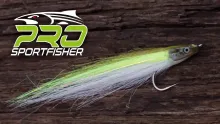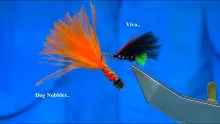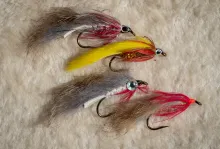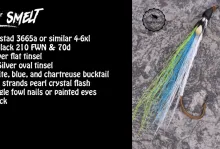Candlefish Bucktail tied by Andrew Marshall Tied by: Andrew Marshall Originated by: Roy A. Patrick Source: Streamer Fly Tying and Fishing, Joseph...
Tied by: Andrew Marshall
Originated by: Roy A. Patrick
Source: Streamer Fly Tying and Fishing, Joseph Bates, 1966 pg. 251
Hook: Mustad 79580 #2
Thread: Black 8/0
Body: Silver flat tinsel (embossed if no rib is used)
Ribbing: Silver oval tinsel
Lower wing: White under pale green under pale blue polar bear hair
Middle wing: Red polar bear hair
Top wing: Pale blue under pale green polar bear hair
Topping: French Blue or violet polar bear hair (optional)
Eye: White with black pupil
Head: Black
Notes: The pattern is one of a trio which were developed in the Puget Sound region in pursuit of coho salmon. The pattern came about from the observations of a committee of anglers and was comprised of the colors thought to closely resemble the candlefish, a frequent target of coho. Mr. Letcher Lambuth and Mr. Zell E. Parkhurst are given credit to the pattern's inception in addition to Mr. Roy A. Patrick. The streamer was proven to be quite successful for taking coho, and garnered enough confidence to become one of the few standards found in Northwestern fly boxes. It first be noted that the bunches of hair used in the wing should all be quite minute so that the wing does not grow into something massive and unwieldily. You can visit Andrew's blog Exploring Classic Streamer Patterns for more insight and information of the patterns of Roy A. Patrick.
- Log in to post comments









Comment to #42-2013 - Candlefish Bucktail tied by
Very nicely done Andrew. The colors are stunning.
Comment to #42-2013 - Candlefish Bucktail tied by
Very interesting pattern Andrew, i love the translucency of polar bear...
Comment to #42-2013 - Candlefish Bucktail tied by
Thank-you! I use this trio and variations of them as the mainstay of my salmon fishing/sea-run cutthroat in estuaries and out in the ocean. Small sizes fished with jerky retrieve, to large size on a down-rigger. Tied on tubes for large size instead of hooks to reduce leverage.